Scroll to:
Software Module Development for the Parametric Generation of Truss Structure Geometry in a Two-Dimensional Setting
https://doi.org/10.23947/2687-1653-2021-21-4-376-383
Abstract
Introduction. Truss structures are widespread in construction due to a number of advantages, such as economy, versatility, and scalability. Accordingly, their modeling and calculation are urgent tasks in the design of building structures. Automatic solution to these problems causes an increase in design efficiency, calculation accuracy, and lower costs. The objective of the study is to examine the functionality and operation algorithm of the software module developed by the authors that generates the geometry of two-dimensional truss structures for subsequent modeling.
Materials and Methods. Following the research of the widespread truss configurations, the classification of chords available in the software under consideration is given. The method of parameterizing a truss structure is provided. This method includes base geometric parameters of the structure such as dimensions, model construction rules, and additional features, as well as a comprehensive algorithm. The software is developed in JavaScript.
Results. The software module has been integrated into a web application for calculating two-dimensional rod structures. To illustrate the functionality of the software, the examples of user interface are given as well as an example problem. The example includes configuration and calculation of an inclined truss structure. The results, such as support reactions and internal forces with axial force diagram, are provided.
Discussion and Conclusions. Using this software module within the framework of the tool for calculating rod structures allows for the simplified process of modeling and calculating complex truss structures, design time, and resource reduction. The software module provides tools for specifying various types of structures, applying loads and assigning properties of a rod system, which makes it a useful instrument for design engineers.
Keywords
For citations:
Glushko S.G., Lyapin A.A., Shatilov Yu.Yu., Cherpakov A.V., Haldkar R.K. Software Module Development for the Parametric Generation of Truss Structure Geometry in a Two-Dimensional Setting. Advanced Engineering Research (Rostov-on-Don). 2021;21(4):376-383. https://doi.org/10.23947/2687-1653-2021-21-4-376-383
Introduction. Truss structures are used in various building elements. Structural solutions of trusses are distinguished by a great variety, differing in the set of parameters for their use and optimization. In the world practice of using structures, there are more than 100 various systems differing primarily in the design of the rod interface. The basic typical structural element is a bar that has conjugate fastening with other elements at the nodes. These designs require certain approaches to the calculation and assessment of their reliability. In works [1–6], approaches to some calculation and experimental methods for assessing their reliability are highlighted. Some approaches and calculation schemes for assessing the reliability of defective structures as well as solving the problem of restoring the properties of their individual elements are covered in monographs [7–8].
Rod structures are systems consisting of linear rods connected at nodes. By the nature of the connection of elements in the nodes, systems with rigid nodes, hinged joints of all elements, and the combined ones are distinguished. From the geometric point of view, planar and spatial rod systems are distinguished.
Truss structures are a subcategory of rod systems that remain geometrically unchanged if rigid joints in nodes are replaced with hinged ones. The load is applied to truss structures only at the nodes, and only tensile-compressive forces arise in their elements [9][10].
Truss structures are widespread as elements of buildings and structures. This popularity is due to a number of advantages [11].
Economy — lower material consumption compared to other building structures.
Versatility — the scope of application of trusses is very wide and includes bridges, roof truss systems, cranes, etc.
Scalability — truss length can vary from a few meters to several kilometers.
Due to these characteristics of trusses, their modeling and calculation are urgent tasks in the design of building structures. Automatic solution to these problems causes an increase in design efficiency and calculation accuracy and lower costs [12][13].
The objective of the study is to examine the functionality and operation algorithm of a software module that generates the geometry of two-dimensional truss structures for subsequent modeling. This program module is a component of the SAPRUS service.
Materials and Methods. Since truss structures are panel structures, i.e., they consist of many sections (panels) identical or similar in geometry, it is possible to parametrically generate a model using the relative coordinates of the nodes when specifying the section. The parameters for such modeling are the total dimensions of the entire structure (height and span of the truss) and the number of sections used.
The functionality of the software module under consideration provides for the modeling of truss structures of 6 types of chords and their subtypes, depending on the lattice used (Figure 1).
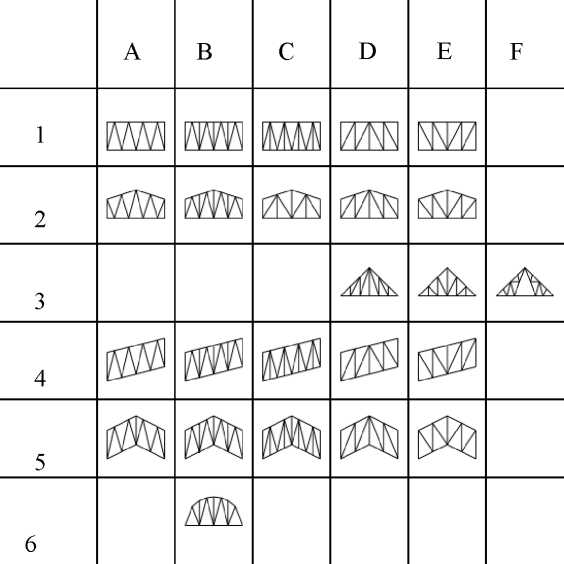
Fig. 1. Structural diagrams used in the module
Classification of the types of trusses used is the following [14][15]:
1. rectangular with parallel chords;
2. trapezoidal;
3. triangular;
4. inclined with parallel chords;
5. inclined from both sides (arrow type);
6. polygonal.
Classification of the types of lattices used is the following:
A. triangular;
B. triangular with uprights;
C. triangular with suspensions;
D. upward diagonal brace;
E. downward diagonal brace;
F. with sub-trusses [16].
JavaScript was used as a programming language for the development of the module. In this regard, the module provides ample opportunities for the implementation of cloud computing of building structures in the web-based interface [17].
The software module is based on the object model, which is an array of objects describing each of the six types of structures. Length l and height h are used as parameters for all types of structures. For truss types 2, 4, 5, the height difference dh is required. For each type of structure, an array of objects describing the geometry of its subtypes is given; it includes the position of nodes and bars, rules for constructing sections (parity, mirroring of structural halves, and usage of separators).
The algorithm of the software module generates, according to the specified parameters, an array of absolute coordinates of nodes of all truss rods. This data is sufficient to describe the model geometry. For a full-fledged definition of a structure model within the module, the following additional features are provided:
- supports;
- hinges;
- offset of the left node relative to the origin of coordinates on the scheme;
- loads on the upper structural nodes;
- element grouping for the convenience of subsequent processing.
The module operation algorithm is the following:
1. Calculation of nodal coordinates for the outer vertical bars of the structure if they exist for the selected structure type.
2. Calculation of the width of individual sections and the coordinates of the nodes of the central support bar of truss type 5.
3. Sequential calculation of nodal coordinates of each section and the formation of rod array.
4. Calculation of the coordinates of nodes for additional vertical bars between sections, if necessary, for the selected subtype of the structure.
5. Preliminary visualization of the structure diagram inside the module.
6. Assignment of the additional properties.
7. Data transfer for design and calculation.
After the data has been transferred, the array has to be further processed to add generated elements to the existing collections. Depending on the specific requirements of the wrapper application, this process can be vastly different. The flowchart of the algorithm used in SAPRUS service is shown in Figure 2.
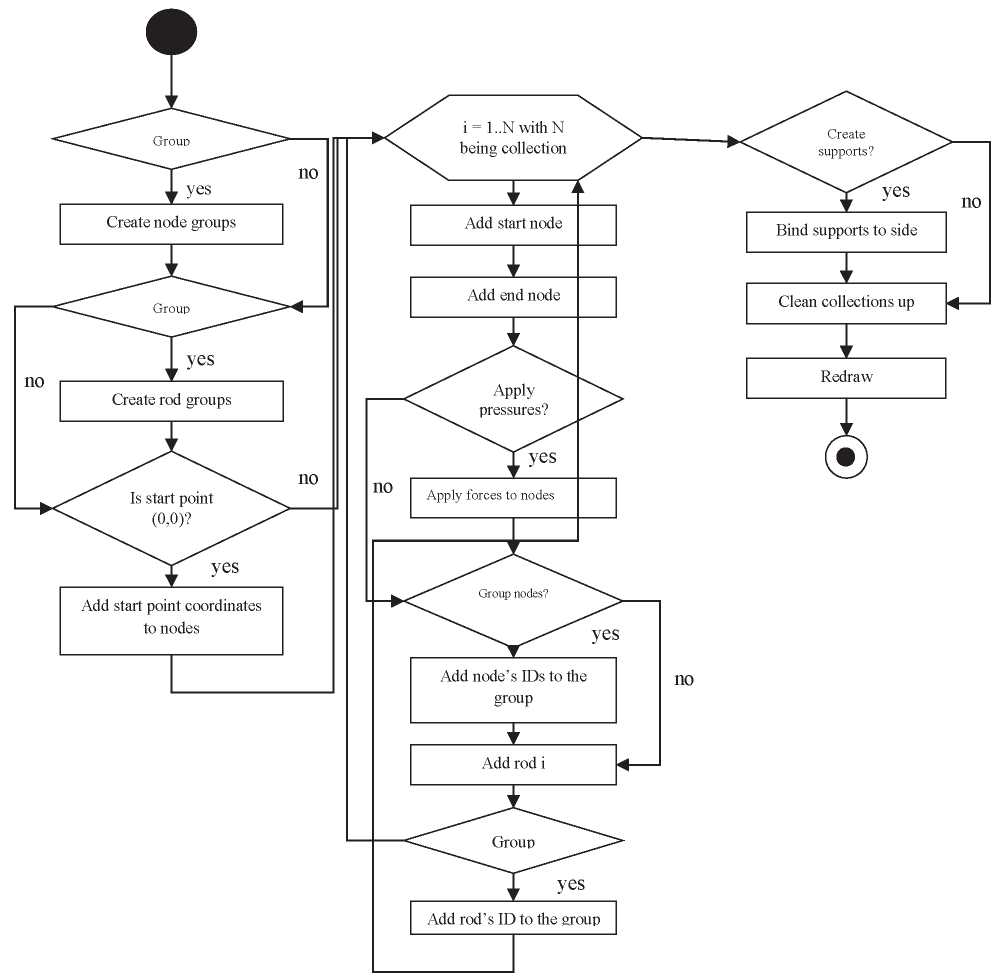
Fig. 2. Post-processing flowchart
As a result, 2 collections are created: CollectionNodes and CollectionRods. The data stored in these collections is suitable for further manipulation and calculations.
Results. When the module is integrated into a web application for calculating two-dimensional rod structures, the choice of the type and subtype of the scheme occurs in the graphical user interface. To enter truss dimensions as well as additional parameters, fields and switches are used. If the type of truss and parameters are changed, the preliminary design scheme is rebuilt automatically.
To illustrate the role of the module within the framework of a web application, we will demonstrate the design and calculation of an inclined structure 20 m long, 10 m high with 3 m offset and consisting of 5 sections (panels). In the nodes of the upper chord of this structure, concentrated forces of 5 kN are applied vertically, for the left and right-most nodes, this force is reduced by 50 % automatically with the Point Load Factor option. The module interface and the result structure diagram are shown in Figure 3. The structure is calculated with the finite element method [18][19]. The resulting diagram of axial forces is shown in Figure 4.
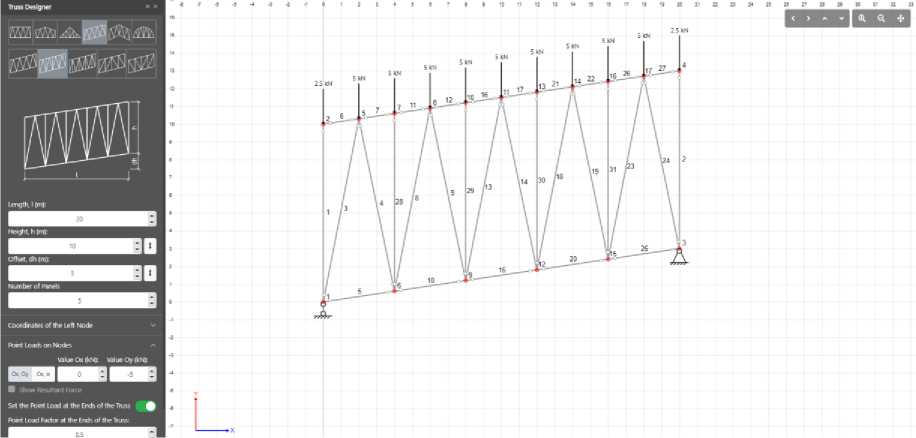
Fig. 3. Configuration window and visualization of the structure diagram
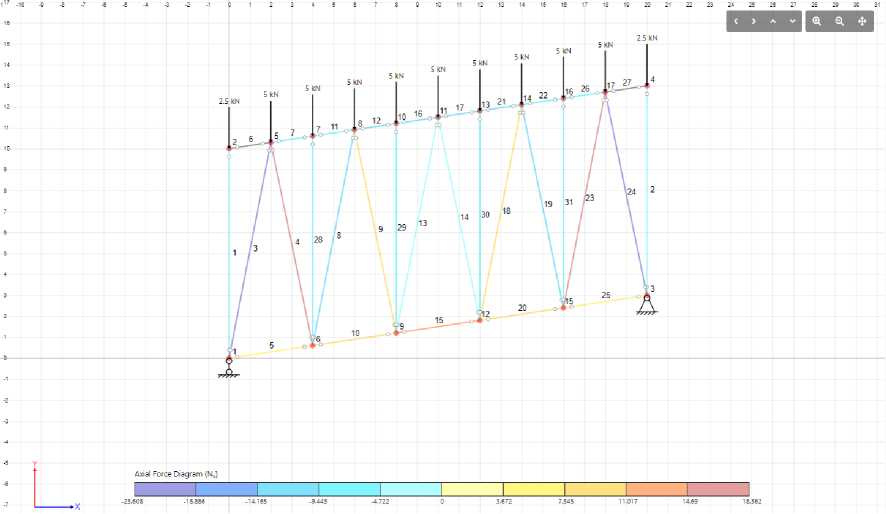
Fig. 4. Axial force diagram
The values of support reactions and internal forces of the calculated structure are presented in Tables 1 and 2, respectively. In Table 1, R is the vertical component of the support reaction, H is the horizontal component of the support reaction, M is the bending moment.
Table 1
Support reactions

Table 2
Internal forces
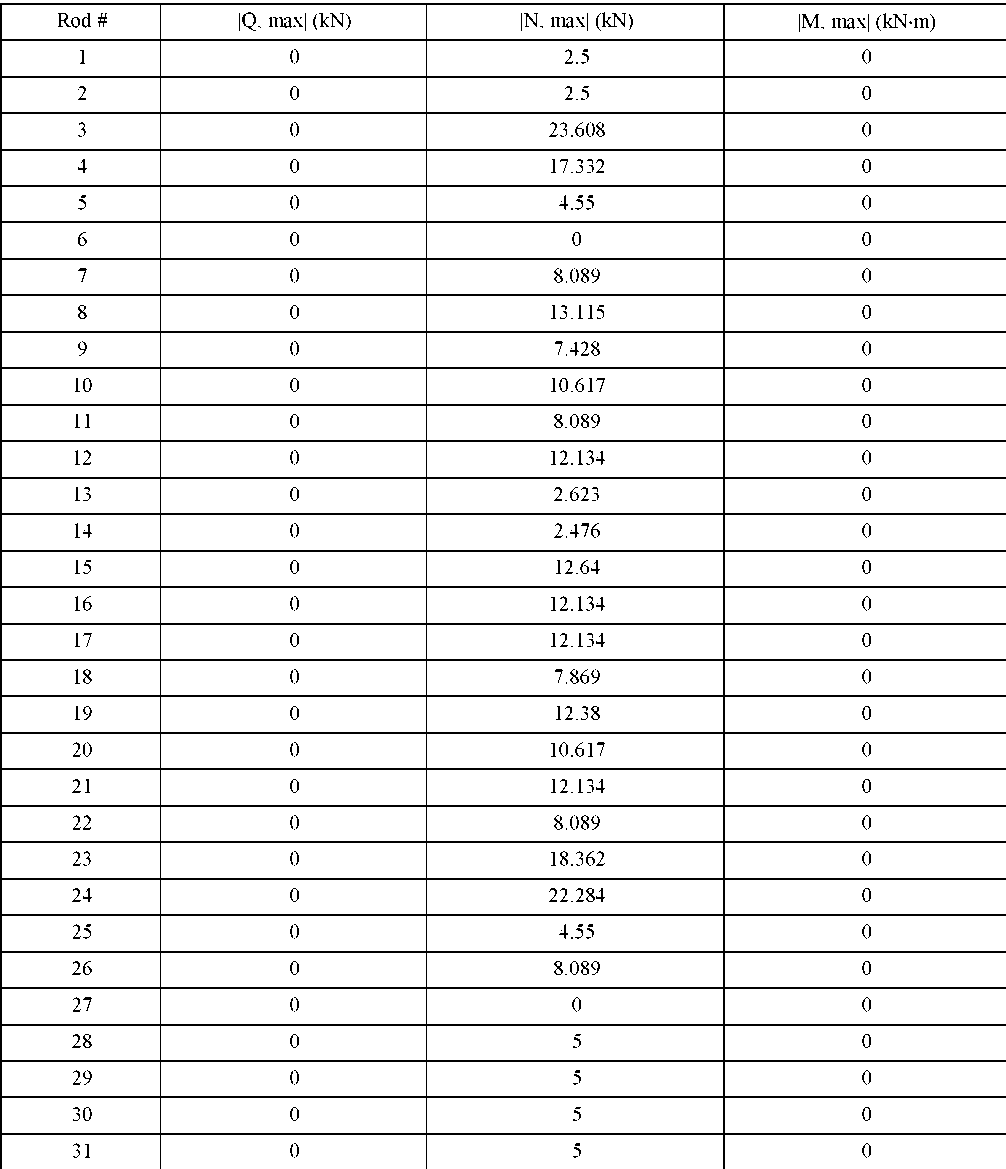
Discussion and Conclusions. Using this software module within the framework of the tool for calculating rod structures allows for the simplified process of modeling and calculating complex truss structures, design time, and resource reduction. The software module provides tools for specifying various types of structures, applying loads and assigning properties of a rod system, which makes it a useful instrument for design engineers.
References
1. Berger M, Tusnin A. Stress redistribution in flat damaged trusses. E3S Web of Conferences. 2019;97:04033. https://doi.org/10.1051/e3sconf/20199704033
2. Rojíček J, Paška Z, Fusek M, et al. Optimization of a Truss Structure Used to Design of the Manipulator Arm from a Set of Components. Applied Sciences. 2021;11:10193. https://doi.org/10.3390/app112110193
3. Shatilov YY, Lyapin AA. Vibration-based damage detection techniques for health monitoring of construction of a multi-storey building. Materials Science Forum. 2018;931:178–183. https://doi.org/10.4028/www.scientific.net/MSF.931.178
4. Lyapin A, Shatilov Yu. Assessment of building structure using data from dynamic monitoring. IOP Conference Series: Materials Science and Engineering. 2018;365:052031. https://doi.org/10.1088/1757- 899X/365/5/052031
5. Soloviev AN, Parinov IA, Cherpakov AV, et al. Experimental vibration diagnostics of the floor plate set of building construction. Lecture Notes in Mechanical Engineering. 2021. P. 255–260. https://doi.org/10.1007/978-3-030- 69610-8_35
6. Soloviev AN, Parinov IA, Cherpakov AV, et al. Analysis of oscillation forms at defect identification in node of truss based on finite element modeling. Materials Physics and Mechanics. 2018;37:192-197. https://doi.org/10.18720/MPM.3722018_12
7. Lyapin AA, Parinov IA, Buravchuk NI, et al. Improving road pavement characteristics. Applications of industrial waste and finite element modelling. Springer Cham; 2021. 236 p. https://doi.org/10.1007/978-3-030-59230-1
8. Shevtsov SN, Soloviev AN, Parinov IA, et al. Piezoelectric actuators and generators for energy harvesting: Research and Development. Springer Cham; 2018. 182 p. https://doi.org/10.1007/978-3-319-75629-5
9. Smirnov VA, Gorodetsky AS. Tekhnicheskaya mekhanika. Moscow: Yurait; 2013. 423 p. (In Russ.)
10. Bakošová A, Krmela J, Handrik M. Computing of truss structure using MATLAB. Manufacturing Technology. 2020;20:279–285. https://doi.org/10.21062/mft.2020.059
11. Kopytov MM, Plyaskin AS. Prostranstvennye sterzhnevye konstrukcii pokrytij. Tomsk: TSUAB; 2019. 104 p. (In Russ.)
12. Vasilkin A. Mathematical and computer modeling in the design of steel rod structures. Journal of Physics: Conference Series. 2019;1425:012172. https://doi.org/10.1088/1742-6596/1425/1/012172
13. Fedorov SS. Principles of creation of models and technologies of high-quality designing of construction objects. Building and Reconstruction. 2018;80:94-101. (In Russ.)
14. Faibishenko VK. Metallicheskie konstruktsii. Moscow: Stroiizdat;1984. 336. (In Russ.)
15. Kirsanov MN. The choice of a lattice for the frame farm. Structural Mechanics of Engineering Constructions and Buildings. — 2017, 3: — P. 23–27. (In Russ.)
16. Kirsanov MN, Gavrilenko AB. Analytical evaluation of stiffness of the truss. Building and reconstruction. 2018;76:12–17. (In Russ.)
17. David Flanagan. JavaScript: The Definitive Guide, 7th ed. O’Reilly Media; 2020. 706 p.
18. Klaus-Jurgen Bathe. Finite Element Procedures, 2nd ed. Watertown, MA: K.J. Bathe; 2014. 1035 p.
19. Seshu P. Textbook of Finite Element Analysis, 10th edition. New Delhi: PHI Learning Private Limited; 2012. 330 p.
About the Authors
S. G. GlushkoRussian Federation
Glushko, Sergey G., postgraduate student of the Information Systems in Construction Department
1, Gagarin Sq., Rostov-on-Don, 344003
A. A. Lyapin
Russian Federation
Lyapin, Alexander A., professor of the Information Systems in Construction Department, Dr.Sci. (Eng.), professor
Yu. Yu. Shatilov
Russian Federation
Shatilov, Yuri Yu., associate professor of the Information Systems in Construction Department, Cand.Sci. (Eng.), associate professor
A. V. Cherpakov
Russian Federation
Cherpakov, Alexander V., Senior Research Scholar, Vorovich Research Institute for Mathematics, Mechanics, and Computer Science, Cand.Sci. (Eng.),
R. K. Haldkar
India
Haldkar Rakesh K., Leading Researcher, Vorovich Research Institute for Mathematics, Mechanics, and Computer Science, Southern Federal University;, G H Raisoni College of Engineering
8a, Milchakova St., Rostov-on-Don, 344090;
Nagpur, India
Review
For citations:
Glushko S.G., Lyapin A.A., Shatilov Yu.Yu., Cherpakov A.V., Haldkar R.K. Software Module Development for the Parametric Generation of Truss Structure Geometry in a Two-Dimensional Setting. Advanced Engineering Research (Rostov-on-Don). 2021;21(4):376-383. https://doi.org/10.23947/2687-1653-2021-21-4-376-383












































